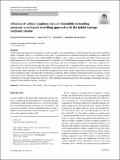| dc.contributor.author | Wechsuwanmanee, Peerapon | |
| dc.contributor.author | Lian, Junhe | |
| dc.contributor.author | Shen, Fuhui | |
| dc.contributor.author | Münstermann, Sebastian | |
| dc.date.accessioned | 2021-09-20T17:22:20Z | |
| dc.date.available | 2021-09-20T17:22:20Z | |
| dc.date.issued | 2020-07-19 | |
| dc.identifier.uri | https://hdl.handle.net/1721.1/131576 | |
| dc.description.abstract | Abstract
Experimental and numerical investigations on the description of cold formability of extra abrasion-resistant steel considering surface roughness effects were performed in this study. A novel multiscale numerical approach to quantitatively evaluate the impacts of surface roughness on the cold formability/bendability of heavy plates was proposed and verified. The macroscopic ductile damage behavior of the investigated steel was described by a hybrid damage mechanics model, whose parameters were calibrated by notched round-bar (NRB) tensile tests and single-edge notched bending (SENB) tests. The surface roughness was characterized by confocal microscopy and statistically incorporated into a two-dimensional representative volume element (RVE) model. For the assessment of the bendability of heavy plates in the component level, the critical ratio between the punch radius and the sample thickness r/t in three-point bending tests was predicted and compared with experimental results. After the surface roughness effects were taken into consideration, a significant improvement in the predicted results was achieved. A good match between the simulation and experimental results confirmed the indispensable influences of surface roughness on the bendability of steels and validated the efficiency of the multiscale simulation approach in the quantitative description of surface roughness affected ductile damage evolutions. | en_US |
| dc.publisher | Springer Paris | en_US |
| dc.relation.isversionof | https://doi.org/10.1007/s12289-020-01576-7 | en_US |
| dc.rights | Creative Commons Attribution | en_US |
| dc.rights.uri | https://creativecommons.org/licenses/by/4.0/ | en_US |
| dc.source | Springer Paris | en_US |
| dc.title | Influence of surface roughness on cold formability in bending processes: a multiscale modelling approach with the hybrid damage mechanics model | en_US |
| dc.type | Article | en_US |
| dc.contributor.department | Massachusetts Institute of Technology. Impact and Crashworthiness Laboratory | |
| dc.contributor.department | Massachusetts Institute of Technology. Department of Mechanical Engineering | |
| dc.identifier.mitlicense | PUBLISHER_CC | |
| dc.eprint.version | Final published version | en_US |
| dc.type.uri | http://purl.org/eprint/type/JournalArticle | en_US |
| eprint.status | http://purl.org/eprint/status/PeerReviewed | en_US |
| dc.date.updated | 2020-07-20T03:47:20Z | |
| dc.language.rfc3066 | en | |
| dc.rights.holder | The Author(s) | |
| dspace.embargo.terms | N | |
| dspace.date.submission | 2020-07-20T03:47:20Z | |
| mit.license | PUBLISHER_CC | |
| mit.metadata.status | Authority Work and Publication Information Needed | |
